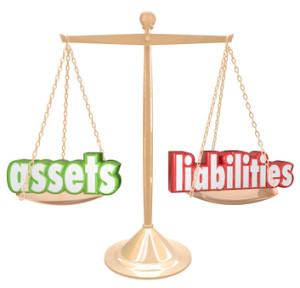 In a previous post, we discussed why it’s important to create a personal balance sheet in order to build your wealth plan. Creating your balance sheet is a crucial first step in understanding your finances so you can plan for the future.
In a previous post, we discussed why it’s important to create a personal balance sheet in order to build your wealth plan. Creating your balance sheet is a crucial first step in understanding your finances so you can plan for the future.
What information is in a balance sheet? It shows your assets and their values listed on one side and your liabilities (the amounts you owe somebody) on the other side. The difference is your net worth.
Assets:
Your assets can be broken down into several categories:
1. Cash and cash equivalents. This includes your cash on hand, bank accounts, CDs and any brokerage accounts that have money market accounts. You can get their values from your most recent statement (either in print or online) or call the institution where the cash is held and ask them for the figure.
2. Notes and accounts receivables. These are moneys owed to you. Most often this occurs in a business setting; however, it also includes personal loans you expect to be repaid.
3. Investments. Stocks, bonds, mutual funds, retirement accounts, annuities, real estate investment trusts (REITS), partnerships, etc. should be included here. Again the values can be determined from your print or online statements. Some interests may be more difficult to value so you can call the place where the investment is held or your advisor or CPA for help.
4. Real Estate. This includes your primary and vacation homes (house, condo or co-op), rental or investment properties, vacant land, etc. Since these are more difficult to value, contact your real estate agent, attorney or CPA for assistance.
5. Life Insurance. Here you need to determine the death benefit on the policy and whether it has a cash value you can borrow on or withdraw. If you’re not sure, ask your agent.
6. Your business interest. Do you own an interest in an active business? This too should be valued. It is one of the more difficult assets to value and many people just include the amount they would sell it at if offered that amount. Ideally, look to your attorney, CPA or a business evaluation for guidance.
7. Collectibles. Artwork, cars, stamp collections, rare coins, gold, etc. should be listed. Again these can be very difficult to value and help can be found with appraisers, attorneys and CPAs.
8. Miscellaneous assets. These are items not listed above that can be sold for some value such as jewelry, a car, furniture, etc. Appraisers can help with the valuation or a rough guess of what you would sell them for is a starting point.
Liabilities:
Next we move to the liabilities side of the balance sheet. Liabilities consist of a mortgage (the amount still owed), rent, credit card bills, insurance, utilities, taxes, car loans, student loans and personal loans as well as any other amount owed by you.
The amounts owed can be found on your bank and credit card statements or calling your lender directly.
Once you know your assets and liabilities, your net worth is the difference between the two.
You should prepare your balance sheet no less than once a year (at year end is typical). Whenever you update your balance sheet you should be comparing it to the last time in order to track how you are doing and whether you are allocating your assets correctly. Your financial advisor can help with this.
There are many software packages you can buy or download to help you produce a balance sheet. Many people just use Excel or go old school with pencil and paper. The important thing is actually putting it together so you can begin to truly understand your finances.
In our next post, we’ll cover how to figure out your cash flow.